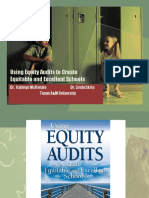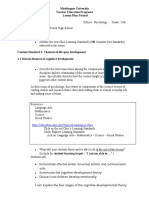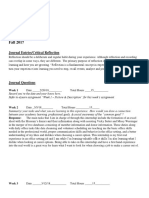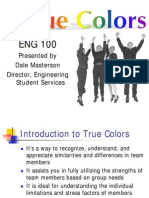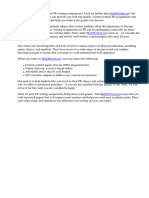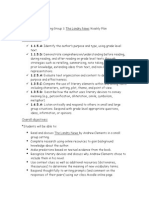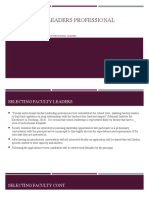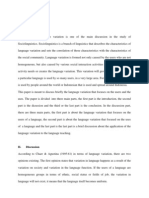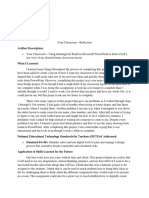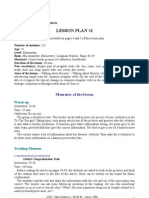The Six Areas of The PLTS Framework: Independent Enquirers Team Workers
The Six Areas of The PLTS Framework: Independent Enquirers Team Workers
Uploaded by
rafaelmariasanchezCopyright:
Available Formats
The Six Areas of The PLTS Framework: Independent Enquirers Team Workers
The Six Areas of The PLTS Framework: Independent Enquirers Team Workers
Uploaded by
rafaelmariasanchezOriginal Description:
Original Title
Copyright
Available Formats
Share this document
Did you find this document useful?
Is this content inappropriate?
Copyright:
Available Formats
The Six Areas of The PLTS Framework: Independent Enquirers Team Workers
The Six Areas of The PLTS Framework: Independent Enquirers Team Workers
Uploaded by
rafaelmariasanchezCopyright:
Available Formats
The six areas of the PLTS framework
Independent enquirers
Team workers
Focus: Young people process and evaluate information in their
investigations, planning what to do and how to go about it. They
take informed and well-reasoned decisions, recognising that others
have different beliefs and attitudes.
Young people:
identify questions to answer and problems to resolve
plan and carry out research, appreciating the consequences of
decisions
explore issues, events or problems from different perspectives
analyse and evaluate information, judging its relevance and
value
consider the influence of circumstances, beliefs and feelings on
decisions and events
support conclusions, using reasoned arguments and evidence.
Focus: Young people work confidently with others, adapting to
different contexts and taking responsibility for their own part. They
listen to and take account of different views. They form collaborative
relationships, resolving issues to reach agreed outcomes.
Young people:
collaborate with others to work towards common goals
reach agreements, managing discussions to achieve results
adapt behaviour to suit different roles and situations, including
leadership roles
show fairness and consideration to others
take responsibility, showing confidence in themselves and their
contribution
provide constructive support and feedback to others.
Effective participants
Self managers
Focus: Young people actively engage with issues that affect them
and those around them. They play a full part in the life of their
school, college, workplace or wider community by taking
responsible action to bring improvements for others as well as
themselves.
Young people:
discuss issues of concern, seeking resolution where needed
present a persuasive case for action
propose practical ways forward, breaking these down into
manageable steps
identify improvements that would benefit others as well as
themselves
try to influence others, negotiating and balancing diverse views
to reach workable solutions
act as an advocate for views and beliefs that may differ from
their own.
Focus: Young people organise themselves, showing personal
responsibility, initiative, creativity and enterprise with a commitment
to learning and self-improvement. They actively embrace change,
responding positively to new priorities, coping with challenges and
looking for opportunities.
Young people:
seek out challenges or new responsibilities and show flexibility
when priorities change
work towards goals, showing initiative, commitment and
perseverance
organise time and resources, prioritising actions
anticipate, take and manage risks
deal with competing pressures, including personal and workrelated demands
respond positively to change, seeking advice and support when
needed
manage their emotions, and build and maintain relationships.
Reflective learners
Creative thinkers
Focus: Young people evaluate their strengths and limitations,
setting themselves realistic goals with criteria for success. They
monitor their own performance and progress, inviting feedback
from others and making changes to further their learning.
Young people:
assess themselves and others, identifying opportunities and
achievements
set goals with success criteria for their development and work
review progress, acting on the outcomes
invite feedback and deal positively with praise, setbacks and
criticism
evaluate experiences and learning to inform future progress
communicate their learning in relevant ways for different
audiences.
Focus: Young people think creatively by generating and exploring
ideas and making original connections. They try different ways to
tackle a problem, working with others to find imaginative solutions
and outcomes that are of value.
Young people:
generate ideas and explore possibilities
ask questions to extend their thinking
connect their own and others ideas and experiences in inventive
ways
question their own and others assumptions
try out alternatives or new solutions and follow ideas through
adapt ideas as circumstances change.
The new secondary curriculum
Key areas of online support:
Aims download the Aims of the curriculum PDF
A big picture of the curriculum view the video clip of Mick Waters
(Director of Curriculum) talking through a big picture of the curriculum
and download the latest version of the big picture
Skills download the PLTS framework PDF, access more detailed
guidance and explore how each subject relates to PLTS
Curriculum in action view case studies of how schools have developed
PLTS in their curriculum
Online tools to help you embed PLTS in your curriculum.
This leaflet links to further guidance
available on the secondary curriculum
website (www.qca.org.uk/curriculum),
as well as guidance provided on the
CfBT website
(www.newsecondarycurriculum.org).
Order ref: QCA/08/3606
ISBN: 978-1-84721-609-0
Qualifications and Curriculum Authority, 83 Piccadilly, London W1J 8QA. Website: www.qca.org.uk
What are PLTS?
QCA has developed a framework for describing personal, learning
and thinking skills (PLTS) that applies to all young people aged 1119.
The personal, learning and thinking skills framework comprises six
groups:
independent enquirers
creative thinkers
reflective learners
team workers
self-managers
effective participants.
These generic skills, together with the functional skills of English,
mathematics and ICT, are essential to success in life, learning and
work.
What are we trying to achieve?
How will we organise the learning?
The aims of the curriculum are that young people should become
successful learners, confident individuals and responsible citizens. The
development of PLTS is an essential part of meeting these aims. PLTS
have considerable impact on young peoples ability to enter work and
adult life as confident and capable individuals who can make a
positive contribution to society.
For PLTS to be effective it is essential that schools and colleges
personalise the way they work with them, in order to best meet the
needs of their learners and broader communities.
Once you are clear about what you want to achieve, you can make
decisions about the best ways to organise learning. A curriculum
with maximum impact uses coherent themes to link learners
experiences across the school. Schools need to determine what
learning opportunities, events and experiences are necessary to
ensure that PLTS are developed according to their schools specific
aims. Opportunities need to be created where these skills are
explicitly taught or articulated, practiced in different contexts, and
reinforced over an extended period of time, so that young people
can reflect on the development of their PLTS.
Take time to consider the six areas of the PLTS framework. Consider
how these relate to your learners. Keep the following questions in
mind during your planning:
Careful planning is necessary to ensure that PLTS are successfully
integrated. Across the curriculum, young people should have the
opportunity to:
What can your learners do already?
What do your learners need to know, understand and be
able to do?
What skills and personal qualities do you want them to develop?
How can you build on previous learning?
How will this contribute to future skills development?
They are embedded within the new Diploma qualification so that they
form an integral part of teaching and learning.
Working with the PLTS framework
For each group of PLTS, a focus statement sums up the range of skills
and qualities involved. This is accompanied by a set of outcome
statements that are indicative of the relevant skills, behaviours and
personal qualities. Each group of skills is distinctive and coherent. The
groups are also interconnected and learners are likely to encounter
skills from several groups in any one learning experience. To develop
independence, learners need to apply skills from all six groups in a
wide range of contexts.
How will we know when we are
achieving our aims?
You will only be able to evaluate the impact of PLTS if you have
been clear about both expectations and learning outcomes from
the start.
To evaluate the impact effectively, you will need to establish what
skills learners already possess. During the experience, observe and
collect evidence of success from a wide range of sources
appropriate to the context. It is essential that you develop a clear
understanding of how your learners will develop their skills and
competencies in relation to particular learning experiences.
Learners will need to consider how they can apply existing skills to
new and unfamiliar areas, and how they will develop these skills.
Remember to consider various perspectives when evaluating a
young persons progress. In addition to teachers, ask peers to assess
each other and seek the opinions of parents and guardians.
plan and complete tasks in real settings or environments,
sometimes outside the classroom
participate fully in the daily life of the school and discuss
concerns, developing creative ideas and actions to address issues
in their school and wider community
take on new responsibilities and work flexibly as situations
change, organising their own time and resources
think and reflect on what they are doing and what they want to
find out
work in groups, taking on roles and responsibilities, sharing and
refining ideas, evaluating each others work, and questioning the
assumptions behind particular ideas
communicate in a variety of ways and present their ideas to a
range of others, for example their class, teachers, a school
assembly, or people outside school.
Consider what learner progression in PLTS might look like:
Identify examples of young people demonstrating particular
skills.
How did they improve and how did you know?
Are they able to use existing skills and competencies in new
areas?
Gather evidence of what learners achieve in the six PLTS areas.
Consider:
How will you gather evidence and share it with others in ways
which are effective and manageable?
Who is this evidence for?
How can you ensure the evidence informs and impacts
on learning?
What are we trying to achieve?
How will we organise the learning?
How will we know when we are achieving our aims?
We want all young people to be engaged with learning and to
recognise the value and importance of education in their lives. The
advice provided in this leaflet will help you to raise standards, so that
all learners can meet the challenges of life in our fast-changing world.
Go to Skills and then PLTS. Use
the online tool (View PLTS in the
curriculum) to explore how each
subject relates to PLTS.
Go to the Subjects section and follow the links to your subject.
Consider each importance statement in relation to the PLTS
framework.
Go to the Developing your curriculum section and then Introduction
to activities. Navigate to Q1: What are we trying to achieve? and
finally Summary. Download resource sheet F to record what your
learners are like now and what you would like them to achieve as a
result of developing PLTS.
Before you plan your curriculum
you need to establish how
effective you are currently are at
developing PLTS skills.
Go to the Skills section and
follow the links to PLTS and
Guidance. Here you can view
two filmed case studies of
schools planning for PLTS
across the curriculum.
Go to Organising your curriculum and then Principles of curriculum
design. Click on see Mick Waters in the What is a curriculum?
section to view a video clip explaining the big picture of the
curriculum. In light of this, consider how the learning experience you
are planning provides opportunities for the development of PLTS.
Go to Developing your curriculum, then Introduction to activities and
How do we organise learning? In the Turning vision into reality
section, download resource sheet C. This will help you reflect on your
current curriculum, and on how you might organise resources and
teaching and assessment approaches to better meet your aims.
ONLINE SUPPORT
The guidance is built around the three curriculum questions:
Go to the Aims section and
download the Aims of the
curriculum PDF. Compare these
with what you are trying to
achieve for your learners through
PLTS.
ONLINE SUPPORT
This leaflet will support schools in planning and implementing PLTS
the qualities and skills needed for success in learning and life.
ONLINE SUPPORT
What is the purpose of this leaflet?
To find examples of how
schools have considered these
questions, go to the Skills
section of the website and
follow the link to PLTS. Use the
View PLTS in the curriculum
sidebar to navigate to a
particular subject.
Use the advice in the
Evaluating your curriculum
section. Click on how well you
are achieving your aims and view the whole page for further
information. Resource sheet E (in the timely information section)
and resource sheet F (in the summary section) will support you in
evaluating the impact of PLTS on your learners.
Support for the Diploma
PLTS are essential to achieving the aims of the Diploma.
Go to www.qca.org.uk/diploma and follow the links to Delivering
the Diploma and then Recording PLTS in Diplomas. Download the
guidance document on this webpage. This provides guidelines on
recording PLTS in teaching and learning for those involved in
planning and delivering Diploma programmes.
You might also like
- Soar Lesson Plan HandbookDocument99 pagesSoar Lesson Plan HandbookNeoSaga100% (2)
- Using Equity Audits To Create Equitable and ExcellentDocument46 pagesUsing Equity Audits To Create Equitable and ExcellentAce007DNo ratings yet
- Pbis Action Plan 2019-20Document6 pagesPbis Action Plan 2019-20api-249671748No ratings yet
- Muskingum University Teacher Education Programs Lesson Plan FormatDocument8 pagesMuskingum University Teacher Education Programs Lesson Plan Formatapi-533882908No ratings yet
- Diversity Equity Inclusion Choice BoardDocument2 pagesDiversity Equity Inclusion Choice Boardapi-518654364100% (1)
- Campus DifusionDocument1 pageCampus Difusionrafaelmariasanchez0% (1)
- Curr Dev ReportDocument32 pagesCurr Dev ReportVia Faye Marie Mea100% (2)
- (Kuliah 6) Critical ReviewDocument11 pages(Kuliah 6) Critical Reviewrina fajarNo ratings yet
- Reflective JournalsDocument4 pagesReflective Journalsapi-383942416No ratings yet
- Edutopia Finley Planning Curric Unit PDFDocument2 pagesEdutopia Finley Planning Curric Unit PDFbeadurmar100% (1)
- DI Educators Guide - Print PDFDocument61 pagesDI Educators Guide - Print PDFioana calugareanuNo ratings yet
- Drago-Severson Article 12 14Document5 pagesDrago-Severson Article 12 14api-362435059No ratings yet
- Peter Senge and The Learning OrganisationDocument12 pagesPeter Senge and The Learning OrganisationSrikari KaparthiNo ratings yet
- Summer Internship JournalDocument4 pagesSummer Internship Journalapi-502768121No ratings yet
- Principles of School ManagementDocument20 pagesPrinciples of School ManagementFazalHayatNo ratings yet
- Presented by Dale Masterson Director, Engineering Student ServicesDocument63 pagesPresented by Dale Masterson Director, Engineering Student ServicesTaryn ReidNo ratings yet
- Learning ContinuumDocument2 pagesLearning ContinuumcorinaNo ratings yet
- Thinking Dispositions ShariDocument5 pagesThinking Dispositions ShariGladys LimNo ratings yet
- Pe Writing AssignmentsDocument7 pagesPe Writing AssignmentswalojxmpdNo ratings yet
- Constructivist Learning Design Key Questions For T... - (Reflection Section Precedents For A Situation Element)Document4 pagesConstructivist Learning Design Key Questions For T... - (Reflection Section Precedents For A Situation Element)Rahayu SulistiyaniNo ratings yet
- Dweck Walton Cohen 2014 PDFDocument43 pagesDweck Walton Cohen 2014 PDFDennis ImNo ratings yet
- The Landry News Reading PlansDocument8 pagesThe Landry News Reading PlansRohmat Cahyono100% (1)
- Diane L. Ronis Brain Compatible Assessments Corwin Press 2007Document231 pagesDiane L. Ronis Brain Compatible Assessments Corwin Press 2007marie100% (1)
- Beyond Behaviour Management Introducing TPSRDocument26 pagesBeyond Behaviour Management Introducing TPSRherkamayaNo ratings yet
- Learning and Teaching: Submitted by Annie Terrence B.ed First Year Department of ENGLISHDocument16 pagesLearning and Teaching: Submitted by Annie Terrence B.ed First Year Department of ENGLISHAnnie TerrenceNo ratings yet
- Maximizing Student Learning With Flexible GroupingDocument4 pagesMaximizing Student Learning With Flexible Groupingapi-291864717No ratings yet
- Nancy Perry, Zark Vanzandt - Exploring Future Options - A Career Development Curriculum For Middle School Students (2006)Document194 pagesNancy Perry, Zark Vanzandt - Exploring Future Options - A Career Development Curriculum For Middle School Students (2006)Priyanshu RajNo ratings yet
- Test-Taking Strategies For The Staar Eoc TestDocument30 pagesTest-Taking Strategies For The Staar Eoc Testapi-2555419470% (1)
- Professional Growth PlanDocument3 pagesProfessional Growth Planapi-338552819No ratings yet
- MotivationDocument37 pagesMotivationKoushik KumarNo ratings yet
- Engaging Adult LearnersDocument10 pagesEngaging Adult LearnersDiana GarciaNo ratings yet
- Career Development TheoriesDocument9 pagesCareer Development TheoriesRica Daniella P. BALUYUT100% (1)
- Planner Teaching As InquiryDocument2 pagesPlanner Teaching As Inquirymerryl8506No ratings yet
- Introduction To Educational ResearchDocument38 pagesIntroduction To Educational ResearchKavinesh KanesonNo ratings yet
- !dok Level Method MatchDocument2 pages!dok Level Method Matchapi-270060627No ratings yet
- Fostering Tolerance and Cultural Awareness Through ELTDocument47 pagesFostering Tolerance and Cultural Awareness Through ELTAnastasia KhodakovaNo ratings yet
- Essential QuestionsDocument16 pagesEssential QuestionsMaria Consuelo Camporedondo JameraNo ratings yet
- Science of Teaching Reading and WritingDocument159 pagesScience of Teaching Reading and WritingkaremNo ratings yet
- Secondary School Personal StatementDocument2 pagesSecondary School Personal StatementAryaan RevsNo ratings yet
- CHAPTER 8: Design and Evaluating Training SystemDocument31 pagesCHAPTER 8: Design and Evaluating Training SystemPaulo LopezNo ratings yet
- Program Evaluation Dissertation Outline: Chapter 1: IntroductionDocument8 pagesProgram Evaluation Dissertation Outline: Chapter 1: IntroductionRoberto Garcia Jr.No ratings yet
- Bloom'S Taxonomy: Affective DomainDocument16 pagesBloom'S Taxonomy: Affective DomainNerie VillanuevaNo ratings yet
- LessonPlanningGuide PDFDocument19 pagesLessonPlanningGuide PDFKaren PerezNo ratings yet
- Hpe Unit - PlanDocument11 pagesHpe Unit - PlanYan ChenNo ratings yet
- Mindsets in The ClassroomDocument2 pagesMindsets in The ClassroomYsabel Grace Belen100% (1)
- Co-Teaching in General Ed Classrooms-1Document27 pagesCo-Teaching in General Ed Classrooms-1teachingfellows100% (1)
- Blooms Taxonomy BreakdownDocument2 pagesBlooms Taxonomy Breakdownapi-115680157No ratings yet
- Actionable Learning A Handbook For Capacity Building Through Case Based LearningDocument528 pagesActionable Learning A Handbook For Capacity Building Through Case Based LearningtoltecayotlNo ratings yet
- Teacher or FacilitatorDocument3 pagesTeacher or FacilitatorSanjay ShindeNo ratings yet
- Discipline Management Strategies in ClassroomDocument5 pagesDiscipline Management Strategies in ClassroomWong Kiiug LikNo ratings yet
- InfusionDocument9 pagesInfusionSheikhLanMapeala100% (1)
- Think TrixDocument8 pagesThink TrixMehlina McEntireNo ratings yet
- DifferentiationDocument2 pagesDifferentiationapi-395831257No ratings yet
- Eight Qualities of A Great Teacher Mentor - Education Week TeacherDocument3 pagesEight Qualities of A Great Teacher Mentor - Education Week Teacherapi-301956394No ratings yet
- Career Management & DevelopmentDocument15 pagesCareer Management & DevelopmentHuleshwar Kumar SinghNo ratings yet
- SIOP Lesson Template Topic, Class, and Level - Which Community Do You Prefer?, Writing, Grade 2Document4 pagesSIOP Lesson Template Topic, Class, and Level - Which Community Do You Prefer?, Writing, Grade 2api-264688073100% (1)
- Jo Harris, Lorraine Cale - Promoting Active Lifestyles in Schools With Web Resource-Human Kinetics (2018) PDFDocument193 pagesJo Harris, Lorraine Cale - Promoting Active Lifestyles in Schools With Web Resource-Human Kinetics (2018) PDFStefano LivieraNo ratings yet
- Taxonomies of LearningDocument22 pagesTaxonomies of LearningRaul Roldan100% (1)
- Critical Thinker NaureenDocument20 pagesCritical Thinker NaureenYasmeen JafferNo ratings yet
- Exemplary Classroom Questioning: Practices to Promote Thinking and LearningFrom EverandExemplary Classroom Questioning: Practices to Promote Thinking and LearningRating: 5 out of 5 stars5/5 (1)
- Text InSPECtion on the Core: Close Reading Strategies for Uncovering Informational TextFrom EverandText InSPECtion on the Core: Close Reading Strategies for Uncovering Informational TextNo ratings yet
- Spanish Courses LondonDocument9 pagesSpanish Courses LondonrafaelmariasanchezNo ratings yet
- Social MediaDocument2 pagesSocial MediarafaelmariasanchezNo ratings yet
- Alliance Between Business and Science)Document1 pageAlliance Between Business and Science)rafaelmariasanchezNo ratings yet
- Course Units 2016-2017: Project: Proposal Form (Stage 2)Document2 pagesCourse Units 2016-2017: Project: Proposal Form (Stage 2)rafaelmariasanchezNo ratings yet
- CourseUnitsStudentHandbook PDFDocument76 pagesCourseUnitsStudentHandbook PDFrafaelmariasanchezNo ratings yet
- Beginners Arabic Study Pack BDocument40 pagesBeginners Arabic Study Pack BrafaelmariasanchezNo ratings yet
- The Sanchez MethodDocument20 pagesThe Sanchez MethodrafaelmariasanchezNo ratings yet
- Spanish 11 Year PlanDocument1 pageSpanish 11 Year PlanrafaelmariasanchezNo ratings yet
- Please Send Your e-MAIL To: ThanksDocument1 pagePlease Send Your e-MAIL To: ThanksrafaelmariasanchezNo ratings yet
- Spanish 5-6 Year PlanDocument1 pageSpanish 5-6 Year PlanrafaelmariasanchezNo ratings yet
- Latin 5-6 Year PlanDocument1 pageLatin 5-6 Year PlanrafaelmariasanchezNo ratings yet
- Latin 7 Year PlanDocument1 pageLatin 7 Year PlanrafaelmariasanchezNo ratings yet
- ¡Listos! 2 Verde Módulo 1 Nos Presentamos: Unidad 1 pp.6-7 Son Muy FamososDocument7 pages¡Listos! 2 Verde Módulo 1 Nos Presentamos: Unidad 1 pp.6-7 Son Muy FamososrafaelmariasanchezNo ratings yet
- School: Class: Module To Be Covered From: To: (Dates) ¡Listos! 3 Verde Módulo 7 de ComprasDocument6 pagesSchool: Class: Module To Be Covered From: To: (Dates) ¡Listos! 3 Verde Módulo 7 de ComprasrafaelmariasanchezNo ratings yet
- Course Plan: Ter M Learning Objectives Learning Activities Sketchbook/portfolio ProgressDocument7 pagesCourse Plan: Ter M Learning Objectives Learning Activities Sketchbook/portfolio ProgressrafaelmariasanchezNo ratings yet
- Listos1 Frameworked Modules1and2Document62 pagesListos1 Frameworked Modules1and2rafaelmariasanchez100% (1)
- Gcse Spa Support 5226Document94 pagesGcse Spa Support 5226rafaelmariasanchezNo ratings yet
- Todos Podemos Colaborar GramaticaDocument3 pagesTodos Podemos Colaborar GramaticarafaelmariasanchezNo ratings yet
- Unidad 1 pp6-7 ¡Hola!: Tú vs. Usted/ustedesDocument8 pagesUnidad 1 pp6-7 ¡Hola!: Tú vs. Usted/ustedesrafaelmariasanchezNo ratings yet
- Hopeful Letter TryoutDocument2 pagesHopeful Letter Tryoutapi-233144528No ratings yet
- Empowering Leaders Professional DevelopmentDocument10 pagesEmpowering Leaders Professional Developmentapi-502786887No ratings yet
- Earth Science SyllabusDocument3 pagesEarth Science Syllabusapi-238888124No ratings yet
- Retention in Online Courses - Exploring Issues and SolutionsDocument11 pagesRetention in Online Courses - Exploring Issues and SolutionsEli RomeroNo ratings yet
- Samantha Lee Cunningham Resume TeachingDocument2 pagesSamantha Lee Cunningham Resume TeachingSamantha CunninghamNo ratings yet
- CURRICULUM CHANGE AND INNOVATION Sha SyaDocument34 pagesCURRICULUM CHANGE AND INNOVATION Sha SyaHulk Hijau100% (1)
- Clil FinlandDocument27 pagesClil Finlandcikgu juniorNo ratings yet
- PBL Workshop GB Day 1Document39 pagesPBL Workshop GB Day 1api-235609000No ratings yet
- 2011 ChoraleDocument16 pages2011 Choralekingkumar5No ratings yet
- Deped Urged: 'Let Jejemon Be It Will Pass': Posted at 05/27/2010 6:01 PM - Updated As of 05/28/2010 9:53 AmDocument6 pagesDeped Urged: 'Let Jejemon Be It Will Pass': Posted at 05/27/2010 6:01 PM - Updated As of 05/28/2010 9:53 AmJayson SalvadorNo ratings yet
- Art Integration Lesson PlanDocument4 pagesArt Integration Lesson Planapi-240819088No ratings yet
- Name: Teacher: Date: Score:: Fractions WorksheetsDocument2 pagesName: Teacher: Date: Score:: Fractions WorksheetsMinchi ChiNo ratings yet
- Grade 11 Department Action PlanDocument3 pagesGrade 11 Department Action PlanHazel ArellanoNo ratings yet
- IDocument18 pagesIShinta Ari HerdianaNo ratings yet
- Edu 214 - Your Classroom - ReflectionDocument2 pagesEdu 214 - Your Classroom - Reflectionapi-459810896No ratings yet
- Experience ReflectionDocument3 pagesExperience Reflectionapi-494417537No ratings yet
- Edited Hots Lac PlanDocument2 pagesEdited Hots Lac PlanLilia RomeroNo ratings yet
- Distance Learning International Welding Engineer International Welding TechnologistDocument2 pagesDistance Learning International Welding Engineer International Welding TechnologistIván Köhler ANo ratings yet
- Differentiation and Learning TheoriesDocument4 pagesDifferentiation and Learning Theorieschrismason1No ratings yet
- Nikki Allred Boyd: Instructor/Choreographer ChoreographyDocument2 pagesNikki Allred Boyd: Instructor/Choreographer ChoreographyNikki AllredNo ratings yet
- RMAX BrochureDocument8 pagesRMAX Brochurecalderon5736No ratings yet
- Introduction To: Seizing The Whip B. K. S. Iyengar and The Making of Modern Yoga, by Eric ShawDocument12 pagesIntroduction To: Seizing The Whip B. K. S. Iyengar and The Making of Modern Yoga, by Eric ShawEric ShawNo ratings yet
- Catherine ConnellyteachresumeDocument3 pagesCatherine Connellyteachresumeapi-270342111No ratings yet
- مهارات التيسير 2011Document59 pagesمهارات التيسير 2011Hamada AhmedNo ratings yet
- Undermining Childrens Intrinsic Interest With ExtDocument10 pagesUndermining Childrens Intrinsic Interest With ExtmglhealNo ratings yet
- Remediation and Intervention RosalDocument15 pagesRemediation and Intervention RosalEuropez Alaskha100% (1)
- Margarito J, Garcia, III, Ph.D. - ED Review (071015) PDFDocument5 pagesMargarito J, Garcia, III, Ph.D. - ED Review (071015) PDFEditorNo ratings yet
- The Place of World Englishes in Composition: Pluralization ContinuedDocument34 pagesThe Place of World Englishes in Composition: Pluralization ContinuedSara HopsonNo ratings yet
- Lesson Plan #1: Moments of The LessonDocument5 pagesLesson Plan #1: Moments of The LessonmeyperezNo ratings yet

